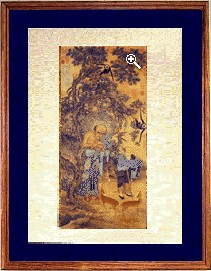
Liu Sung-nien (fl. 1174-after 1194), Sung Dynasty
Framed,
18"x24"
(Original is Hanging scroll, Ink and color on silk; size: 46'x21")
ˇ@
 |
 |
 |
 |
ˇ@
Liu Sung-nien, a native of Chˇ¦ien-tˇ¦ang (modern Hangchow), served during the Chˇ¦un-hsi era (1174-1189) as Student in the Painting Academy and in the following Shao-hsi era (1190-1194) was made Painter-in-Attendance. Following his teacher, Chang Tun-li, Liu specialized in figures and landscapes. With his fine and spirited workmanship, however, Liu surpassed even his teacher. Under Emperor Ning-tsung (r. 1195-1224), Liu was awarded the prestigious Gold Belt after submitting a painting entitled ˇ§Sericulture and Agriculture.ˇ¨
Three paintings of lohans (Buddhist ascetics) in the National Palace Museum collection bear the signature, ˇ§Painted by Liu Sung-nien in the ting-mao year of the Kˇ¦ai-hsi era [1207].ˇ¨ This hanging scroll is one of them. Here, the lohan has long, bushy eyebrows and a prominent nose similar to the features of an Indian monk. With his cassock tied around his left shoulder, the lohan leans on a horizontal tree branch as if in deep thought. An attendant monk stands next to him with sleeves outstretched to catch a pomegranate about to be dropped by one of the gibbons in the branches. In front, two deer stand back-to-back with heads turned upward, one looking at the lohan and the other at the gibbon. The pursed lips, facial hair, and detailed wrinkles make the lohan appear quite realistic. The brushwork is also varied according to what is being depicted. The drapery lines, for example, are exceptionally fluid and even, while the artist even subdued the forms behind the halo to suggest a gauze-like effect. The same attention also went into the coloring, which is brilliantly handled with refinement and restraint, making for a masterpiece of Sung Buddhist painting.
ˇ@
